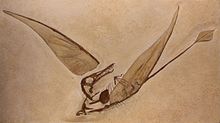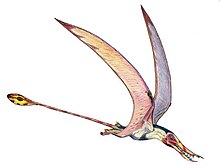
Back Rhamphorhynchus Catalan Odontorhynchus (ulod nga patag) CEB Rhamphorhynchus Czech Rhamphorhynchus German Ramforinko EO Rhamphorhynchus Spanish پوزهمنقاری FA Rhamphorhynchus Finnish Rhamphorhynchus French רמפורינקוס HE
| Rhamphorhynchus Temporal range: Late Jurassic (Tithonian),
| |
|---|---|

| |
| Cast of the first specimen found with wing membranes, Musée de sciences naturelles de Bruxelles | |

| |
| Life restoration of R. muensteri | |
| Scientific classification | |
| Domain: | Eukaryota |
| Kingdom: | Animalia |
| Phylum: | Chordata |
| Order: | †Pterosauria |
| Family: | †Rhamphorhynchidae |
| Clade: | †Rhamphorhynchini |
| Genus: | †Rhamphorhynchus Meyer, 1846 |
| Type species | |
| †Ornithocephalus muensteri Goldfuss, 1831
| |
| Species | |
| |
| Synonyms | |
|
Genus synonymy
Synonyms of R. muensteri
| |
Rhamphorhynchus (/ˌræmfəˈrɪŋkəs/,[1] from Ancient Greek rhamphos meaning "beak" and rhynchus meaning "snout") is a genus of long-tailed pterosaurs in the Jurassic period. Less specialized than contemporary, short-tailed pterodactyloid pterosaurs such as Pterodactylus, it had a long tail, stiffened with ligaments, which ended in a characteristic soft-tissue tail vane. The mouth of Rhamphorhynchus housed needle-like teeth, which were angled forward, with a curved, sharp, beak-like tip lacking teeth, indicating a diet mainly of fish; indeed, fish and cephalopod remains are frequently found in Rhamphorhynchus abdominal contents, as well as in their coprolites.[2]
Although fragmentary fossil remains possibly belonging to Rhamphorhynchus have been found in England, Tanzania, and Spain, the best preserved specimens come from the Solnhofen limestone of Bavaria, Germany. Many of these fossils preserve not only the bones but impressions of soft tissues, such as wing membranes and probably pycnofibers.[3] Scattered teeth believed to belong to Rhamphorhynchus have been found in Portugal as well.[4]
- ^ "Rhamphorhynchus". Lexico UK English Dictionary. Oxford University Press. Archived from the original on 2020-03-22.
- ^ Frey, E.; Tischlinger, H. (2012). "The Late Jurassic pterosaur Rhamphorhynchus, a frequent victim of the ganoid fish Aspidorhynchus?". PLOS ONE. 7 (3): e31945. Bibcode:2012PLoSO...731945F. doi:10.1371/journal.pone.0031945. PMC 3296705. PMID 22412850.
- ^ Cite error: The named reference
Hone2015was invoked but never defined (see the help page). - ^ Rhamphorhynchus. In: Cranfield, Ingrid (ed.). The Illustrated Directory of Dinosaurs and Other Prehistoric Creatures. London: Salamander Books, Ltd. Pp. 302-305.